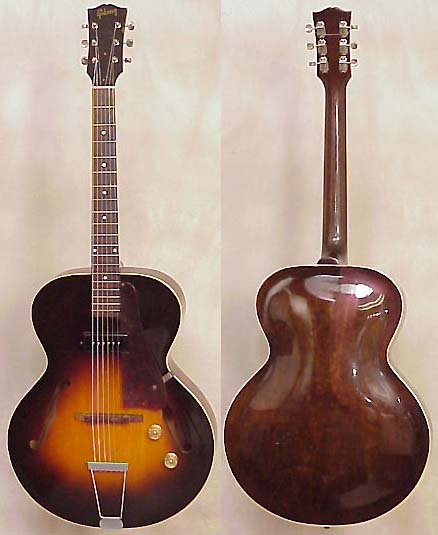 |
| ES-150 |
Gibson introduced it's first commercially successful electric guitar in 1936. This was the ES-150, commonly known as the Charlie Christian model. The instrument was 16 1/4 inches wide and had a single blade pickup in the neck position that was held in place by three screws that were visible on the bodies top under the strings. The screws also adjusted the pickups height.
 |
| L-50 |
Following the success of this guitar, in 1938 Gibson introduced a budget model known as the model ES-100. This instrument was based on Gibson's L-50 arch top acoustic guitar. A pickup was added to the body and placed in the bridge position.
 |
| ES-100 |
The ES-100 was two inches shorter than the ES-150, having a body depth of a mere 14 1/4 inches. It's body was bound on the top and bottom. Within the guitars body were two sound-posts. The guitars arched top was carved and made of spruce. However the back was flat. The neck was unbound and capped with a rosewood fretboard. The tuners were Klusons. The strings were held in place by a trapeze tail-piece.
Originally the pickup on this model was a blade style unit. In 1940 this changed to Gibson's first pole magnet pickup.
 |
| ES-125 |
By 1941, the ES-100 was dropped from the line-up and replaced with the Gibson ES-125 model. Several changes in design occurred.
 |
| ES-125 |
The body on this guitar was now 16 1/4 inches in width and came with a laminated arched maple top, which became Gibson's standard on it's electric hollow body instruments. The back and sides were also made of maple. The pickup was now Gibson's P90 dog-eared unit with adjustable pole-pieces. The body depth was 3 3/4 inches. The unbound solid Honduras mahogany neck was capped with a Brazilian rosewood fretboard which was originally topped with pearloid dot markers. The headstock, like the previously mentioned guitars, was unadorned except for the Gibson logo silk-screened in gold lettering across the top. The guitars pick-guard was made of tortoise-shell style celluloid.
The electronics remained similar to prior models; a single volume and tone potentiometer, but now featured gold tinted bonnet style knobs. The input jack was on the lower rim of the body. The bridge was compensated and made of rosewood.
The tuners, once again, were made by Kluson. The nickel plated tail-piece was trapeze style. The guitar was offered in sunburst.
In 1942, production stopped, due to the war. The model was reintroduced in 1946 when Gibson once again geared up for guitar production.
In 1956, Gibson updated the model, by offering it in their thin-line series, renaming it the ES-125T. All accouterments remained the same except for the body depth, which originally was 3 1/2 inches. The thin-line models depth was 1 3/4 inches.. A year later the model was offered with two P 90 pickups and called the ES-125TD. Both models were produced through 1969 when production ended.
One notable ES 125T players is blues man Roy Rogers.
In 1960, Gibson offered the ES-125TC and the ES-125TCD, both of which had a single Florentine cutaway.
The TC model came with a single P90 pickup up and the TCD (thin-cutaway-double) came with twin P90's.
In 1962 Gibson came up with the ES-120T. This was a student instrument. The body and neck were similar to the ES-125T, except it only had one "F" hole. The lower bout was covered with a large scratch plate which had one single coil pickup, a volume and a tone knob, plus the jack.
Between 1965 and 1970 Gibson produced 475 ES-125C and ES-125CD full bodied guitars. These came with one or two P90 pickups. George Thorogood favored the ES-125CD model.
By 1970 the entire line of Gibson's ES-125 models were discontinued. It's market was aimed at country and jazz style players. But rock players had moved on to the Les Pauls and other solid body guitars and jazz players preferred the fancier Gibson ES-175.









I've just acquired a 1946 es 125 that has a tortoise shell pickguard,trapazoid inlays and all mahogany ply top,back, and sides. I've been told that this was one of the first few built of that year then they went to dots, a black pickguard and maple top and back with mahogany sides. Would this make this model a little more valuable?
ReplyDeleteI just purchased a 1960 ES 125, my first true Gibson. I was so blown away by the action, tone, and beauty of this instrument that I couldn't even haggle on the price offered. The only alteration on it was the previous owner changed out the original tuners with new identical replacements.
ReplyDeleteMy current stage guitar, when playing electric, is a 1964 Martin F-65. It just got replaced... this Gibby is gonna be my main machine hereon.
Yep, love at first sight. The ES 125 is amazing.